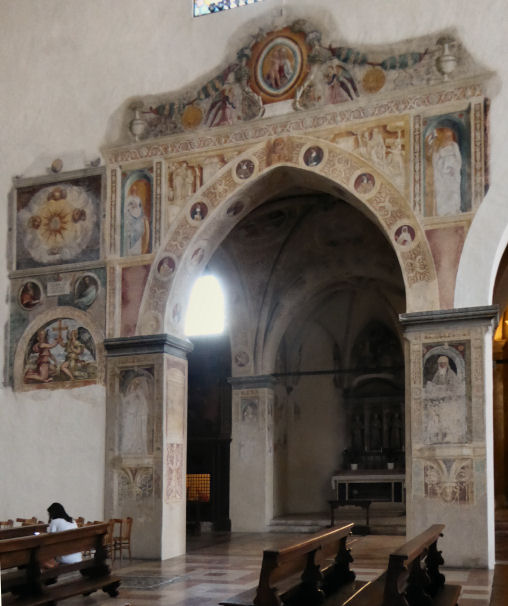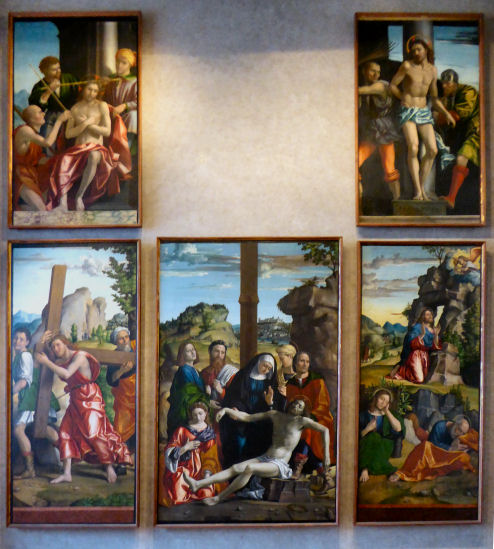|
|
|
History The Franciscan Saint Bernardino from Siena was canonized in 1450, six years after his death, and on 30th April 1452 his friend Giovanni da Capestrano began building this complex with the help of the Venetian doge Francesco Foscari. The church was consecrated in 1453, although the nave and its ceiling were not completed until 1466. Later a smaller aisle was added with chapels being build in the later 15th and earlier 16th century. Suppressed by Napoleon in 1810 and restored from 1930. The convent in this time was been put to use as a cemetery for the city, a barracks, a warehouse and a school. Exterior The church is approached across a large cloister with frescoes in the wall lunettes in a simple style bordering on what one might call naive. The tombs and tablets here date from the period when the cloister housed the town cemetery. The brick fašade has Gothic windows and a Renaissance doorway, from 1474, with statues of three Franciscan saints (Bonaventura, Bernardino and Antonio) on top and a lunette panel showing St Francis Receiving the Stigmata by Biagio Falcieri. Interior A single huge high nave, ideal for preaching, as is usual in Franciscan churches, with nothing to hinder lines of sight. But with a later-added aisle on the right with shallow side chapels, containing 16th century works, and one deep one, the first.  This first chapel is the Terziari, dedicated to Saint Francis with frescoes of the Saint's life in the vault and that of Saint John on the walls. These are the work of Nicol˛ Giolfino. Over the altar here is a copy of Paolo Morando (Cavazzola)'s Pala delle Virt¨ (Altarpiece of the Virtues), the original now being in the Castelvecchio museum (see Lost art below). The second chapel has an altarpiece of the Virgin and Child with Saints by Francesco Bonsignori, looking like it has suffered some later unskilled restoration of the faces. The third chapel contains some disturbingly modern-looking frescos from 1932 looking like Hollywood epic film stills. The modern Adam and Eve is especially unnerving. The fourth, Medici, chapel has frescos inside, above and spreading into the nave (see right) by Domenico Morone (1498). Sinopie of a pair of figures from the columns are displayed on the first two columns on the right as you enter the church. The fifth, the Avanzi Chapel (1546) at the end (see photo below right), is a Who's Who of early 16th century Veronese art. There are panels by Giovan Francesco Caroto (Christ Taking Leave of his Mother, from c. 1525, bottom right on left hand wall - a very rare subject for a main panel), Antonio Badile (The Resurrection of Lazarus, bottom left on left hand wall), Giolfino (remainder of left-hand wall and the Arrest of Jesus opposite), and Cavazzola (Paolo Morando). But the last-named artist's works (all of those on the end wall except the Crucifixion, which is by Francesco Morone from 1497/8) are copies, the originals now being nicely displayed in the Castelvecchio. They are painted lit from the right to reflect the position of the window in this chapel. Under this window and above the lower grilled window (which is into the room with the painted stone group of The Lamentation) is a poor-condition poor copy of Paolo Veroneseĺs very early Christ Revives the Daughter of Jairus of c. 1546. The original was stolen in 1696 when the Viennese art dealer Peter Strudel bribed three monks to replace it with a copy in the middle of the night. The copy, by one Giovanni Cagnoto, was so bad it was spotted immediately and the monks were tried and convicted. The original painting has still not been found, but an oil sketch for it is in the Louvre. It indicates that Cagnoto's copy, whilst not pretty, is pretty accurate. The door to the right before the apse leads to the surprisingly bright and airy and harmoniously proportioned circular Pellegrini Chapel (see photo below right) designed by Michele Sanmicheli and built for Margherita Pellegrini from 1527 in memory of her son Nicol˛. She fired Sanmicheli in 1538 as the work had still not been completed, and hired masons Antonio and Jacopo, but they took a further 20 years and Margherita didn't live to see the chapel's completion. The drum and dome only got finished in the 18th century. It has a very mannerist altarpiece of the Virgin and Child with Saint Anne of 1579 by Bernardino India, flanked by very Caravaggist panels depicting Saints Joachim and Joseph from c.1620 by Pasquale Ottino, who also did the lunette. The apse, frescoed by Michele da Verona, was destroyed by a direct hit during bombing in WWII. It was rebuilt to its original design, but the frescoes were destroyed. A fine tremezzo (rood screen), mentioned in Alethia Wiel's guidebook of 1907, was presumably lost at this time too. The altarpiece is the very Mantagnesque so-called San Bernardino Altarpiece of 1462 by Francesco Benaglio. Along the left wall the first, Baroque, altar is by Francesco Bibiena with an altarpiece by Antonio Balestra of the Three Franciscan Fathers. It's followed by two confessionals, a pulpit, and then a grey temple-looking stone altar with pretty fresco foliage surrounding. It's altarpiece is a Nativity by Bernardo India, with statues of Isaiah and the Cumaean sibyl flanking it. The organ of 1481 has doors painted with San Francesco and San Bernardino by Domenico Morone. Lost art A panel of Saint Francis Receiving the Stigmata by Francesco Morone is in the Castelvecchio, with two panel fragments of Saint Francis and Saint Bartholomew. Also a Washing of the Feet from the Capella della Croce here.  An altarpiece and a predella panel depicting Saint Francis Giving the Rule to the Nuns of Saint Claire by Cavazzola (Paolo Morando) are in the Castelvecchio. Another of the predella panels Saint Francis Dictating the Rule of the Tertiaries, is in Budapest, whilst the third Saint Francis and the Minor Friars, is lost. His Passion Polyptych (1517) replaced by copies in the Cappella degli Avanzi (see above right) now looking glorious in the Castelvecchio (see photo right). (The figure of Nicodemus, with a red beard and wearing a turban, in the central panel is, according to Vasari, a self portrait, and Joseph of Arimathea, supporting Christ, is supposed to be Francesco Morone.) Four panels from the predella of this altarpiece, showing Saints John the Baptist, Joseph, Bonaventura and Bernardino of Feltre, are also in the Castelvecchio. As is, from the Terziari chapel here, where a copy replaces it too, Cavazzola's impressive Pala delle Virt¨ from 1522. The Virgin is depicted in a cloud flanked by Saints Francis and Anthony of Padua and surrounded by putti and seven virtues. The latter are unusual in altarpieces and have identifying attributes (from left to right and top to bottom): Charity has two children, Faith has the host and chalice, Hope just looks up and prays, Justice has a sword and scales, Prudence has compasses here rather than her usual serpent or mirror, Temperance is pouring water and Fortitude has a column. In the earthly realm below six saints surround a donor: Elizabeth of Hungary, Bonaventure and Louis, King of France on one side, Ivo, Louis of Toulouse and Eleazaro on the other. All of these works are in the first room after the outdoor Cannegrande statue in the Castelvecchio, a room thereby dominated by Cavazzola's works from this church. Three predella panels by Caroto, depicting The Birth of the Virgin, The Adoration of the Magi and The Massacre of the Innocents with the Flight into Egypt are in the Carrara in Bergamo. They are said to have painted for the altar dedicated to the Virgin here. His biographer Ridolfi mentions an early Jesus Healing St Peter's Mother in Law by Paolo Veronese, in front of his master Antonio Badile's The Resurrection of Lazarus in the Avanzi Chapel. It has been lost since 1697. (See the story of the copy above). Antonio Balestra's Death of Abel in the Castelvecchio. Opening times (church and library) Monday - Friday: 15.00 - 18.30 Tuesday - Sunday: 08.30 - 12.00 Saturday & holidays 15.30-18.30 It makes sense when you realise that the first and third lines are the afternoon opening times and the second line is the mornings. The Library |
|
|
|
A book (now in the Verona State Archives) detailing the
|